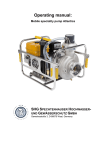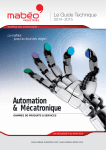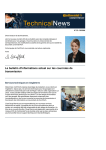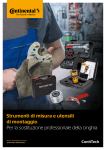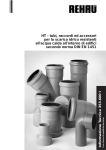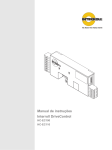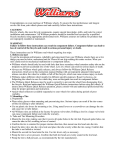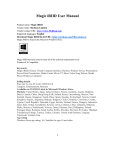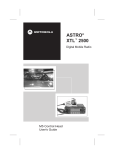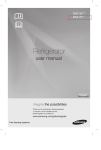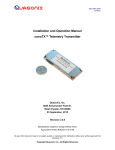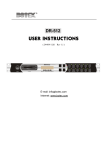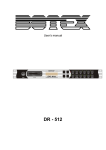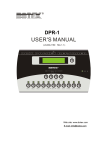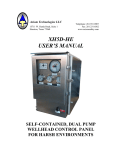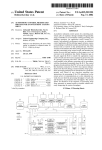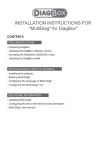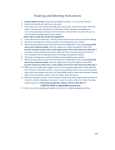Download Contitech Belts User Manual
Transcript
Practical Tips Original quality – the best replacement Power Transmission Group ContiTech Practical Tips Original Equipment quality products – safe, reliable and efficient CONTI-V MULTIRIB® multiple V-ribbed belts CONTI®-SF fan belts The CONTI-V MULTIRIB® multiple V-ribbed belt for standard 1) and serpentine 2) drives in cars and commercial vehicles is extremely safe, reliable and efficient. When fitted in serpentine drives with automatic tensioning, this belt does not need to be retightened. The CONTI®-SF fan belt for standard drives1) in passenger cars and commercial vehicles is maintenance-free, safe, reliable and efficient. This belt does not need to be retensioned once fitted properly. Cover fabric Polyester tension members Synthetic rubber backing Tension member cushioning Polyester tension members Fibrous polychloroprene base compound Fibrous polychloroprene base compound Size designation (example) AVX 10 x 950 AVX profile 10 belt width (mm) 950 total length (mm) Size designation (example) 6 PK 1980 6 number of ribs PK profile designation/ spacing of ribs 3.56 mm 1980 effective length (mm) 1) 2 to 3 pulley drives with a fixed tensioning pulley 2) assemblies lying in one plane and driven by one belt Tensioning pulleys, idler pulleys When opting for multiple V-ribbed belts made by ContiTech, you are choosing a superior product in original equipment quality. To ensure the quality of our products and kits, we only use tensioning pulleys and idlers made by leading suppliers of original equipment. These matching components of a belt drive system ensure that the multiple V-ribbed belt provides the correct tension, guidance and power transmission. Power steering Generator Tensioning pulley Water pump Configuration of a multiple V-ribbed belt Multiple V-ribbed and fan belts / Kits Crankshaft ContiTech Practical Tips Changing the belt correctly – for 100 % drive function 1 2 3 4 Changing a multiple V-ribbed belt If the belt drive has an automatic tensioning system: • Use appropriate tools to move the tensioner to “belt removal”. • Secure the tensioner in this position. (1) • Make sure you are familiar with the belt configuration (drawing a sketch helps). • Remove the belt. • Check tensioner, back idler pulleys and belt pulleys for any wear or damage. (2) • Ensure you have the correct belt size. First place it over the plain and flanged pulleys (3), and then push it over the smooth back idler pulleys. (4) • Check that the belt is properly seated in the grooves. • Release the tensioner securing mechanism with a suitable tool and move the tensioner against the belt. Remove all tools. • Check that the belt is properly seated on all pulleys. • Start the engine and watch that the belt is running along its intended path. • Turn off the engine. Use the Krikit 2 or Krikit 3 tension gauge to check the belt tension on the taut section of the belt (5). If the tension is incorrect, check the tensioning system against the manufacturer’s data. • Dispose of the replaced belt in an environmentally friendly way. If the belt drive includes a fixed tensioning pulley: • Release the tensioning system and move it into the drive unit. • Make sure you are familiar with the belt configuration (drawing a sketch helps). • Remove the belt. • Check tensioner, back idler pulleys and belt pulleys for any wear or damage. • Ensure you have the correct belt size. First place it over the plain and flanged pulleys, and then push it over the smooth back idler pulleys. • Check that the belt is properly seated in the grooves. Multiple V-ribbed belts and fan belts 5 6 CONTI® BTT Hz (Belt Tension Tester): Electronic alternative for measuring the tension of multiple V-ribbed belts Safety tips • Use the Krikit 2 or Krikit 3 tension gauge to check the belt tension on the taut section of the belt. (5) New multiple V-ribbed belts Profile PK: 12 -14 kg/rib Used multiple V-ribbed belts Profile PK: 9 -10 kg/rib • Let the engine run for a few minutes, then switch it off. Check the tension and make any necessary adjustments. • Dispose of the replaced belt in an environmentally friendly way. Changing a fan belt Changing fan belts is similar to changing multiple Vribbed belts with a fixed tensioning pulley. Use the Krikit 1 tension gauge to adjust the belt tension (6). New fan belts Profile AVX 10: 40 kg Profile AVX 13: 55 kg Used fan belts Profile AVX 10: 25 -30 kg Profile AVX 13: 40 -45 kg • When installing belts, only use the correct tool (not a screwdriver). The belt must be installed without the use of force. • Belt dressing or similar materials should be used only in emergencies to eliminate noises. • Never allow caustic or corrosive liquids to come into contact with the belt drive, as they could damage the plastic parts. • Check that the belt pulleys are in flawless condition (no dirt, rust or burrs) and are the correct size for the belt profile. • Ensure that the pulleys are properly aligned parallel to the axis. • V-belt drives in sets contain belts in matched lengths. If any one belt fails, all belts must be replaced. ContiTech Practical Tips Problem – Diagnosis – Solution: Building on experience Checklist Multiple V-ribbed belts Tension • Tensioning system? Damage to the back of the belt • Back idler pulleys/ Back idler roller bearings? • Foreign matter? Unacceptable wear on belt ribs – cracks/separations • • • • Dirt accumulation • Leaks in the engine or engine compartment? Drive noises • Tension? • Pulley alignment? • Dirt accumulation? Foreign matter? Mounting of pulleys? Pulley alignment? Ageing? Checklist Fan belts Tension • Tension system? Wear on flanks • Pulley alignment? Mounting of pulleys? Cracks/separations • Foreign matter? • Ageing? Dirt accumulation • Leaks in the engine or engine compartment? Drive noises • Tension? • Pulley alignment? • Dirt accumulation? Multiple V-ribbed belts and fan belts Problem and cause Multiple V-ribbed belts/fan belts Solution Hardened, polished flanks Incorrect tensioning Tension member of belt damaged Change the belt, adjust tension correctly Change the belt, fit properly by incorrect fitting Uneven wear on ribs Pulleys are not aligned Substantial belt vibrations Examine the drive. Line up or, if necessary, replace any non-aligned pulleys, change the belt Check the tension. If necessary, tighten or change the belt Running noises from belt Insufficient tension Belt past its useful life Tighten or change the belt Change the belt Cracks/separations in belt body/ribs Belt tension is too high/low Belt past its useful life Foreign matter Change the belt, adjust tension correctly Change the belt Crack in the belt after a short running time Tension members damaged as a result of incorrect fitting Belt excessively tensioned Change the belt, fitting it correctly Change the belt, adjust tension correctly Dirt accumulation on the belt Leaks in the engine or engine compartment (e.g. escape of oil, antifreeze etc.) Problem and cause Multiple V-ribbed belts Repair leak(s), change the belt Solution Damage to the back of the belt Back idler pulley defective (sluggish, surface damaged, e.g. by foreign matter) Change the belt, replace the back idler pulleys Unacceptable wear of belt ribs Pulleys/idlers/assemblies defective (sluggish) Pulleys not aligned Problem and cause Fan belts Hardened, polished flanks (different tension values for belts of sets) Pulleys not aligned Tension member of belt damaged by incorrect fitting Mismatching of belts Replace pulleys/idlers/assemblies, change the belt Align or replace pulleys, change the belt Solution Examine the drive, line up non-aligned pulleys and fit a new set of belts Change the belt, fitting it correctly Always replace a complete set of belts Excessive wear on flanks/flanks brittle Excessive slip Pulleys not aligned Pulley grooves with uneven wear Change the belt, adjust the tension correctly Examine the drive, line up or, if necessary, replace any non-aligned pulleys Line up or, if necessary, replace any non-aligned pulleys ContiTech Practical Tips Top-class products – safe to use, low noise, zero maintenance CONTI SYNCHROBELT® timing belts in three different basic profiles (trapezoidal, HTD, STD) ensure synchronous power transmission. They are reliable, quiet and maintenance-free. They are used in passenger car engines to drive camshafts, fuel injection pumps and balancing shafts. CONTI SYNCHROBELT® HTD timing belts Synthetic rubber backing Glass cord tension members with S/Z twists CONTI SYNCHROBELT® trapezoidal timing belts Polychloroprene teeth Polyamide fabric Synthetic rubber backing Glass cord tension members with S/Z twists Profile t (mm) hs (mm) ht (mm) HTD 9.525 M 9.525 5.6 3.45 Polychloroprene teeth ht Polyamide fabric hs t Profile t (mm) hs (mm) ht (mm) LA 9.525 4.1 1.9 LAH 9.525 4.5 2.3 ht CONTI SYNCHROBELT® STD timing belts Synthetic rubber backing hs Glass cord tension members with S/Z twists t Polychloroprene teeth Polyamide fabric q The right timing belts and timing belt kits for all vehicles are listed in the comprehensive ContiTech application guide for passenger cars and in TecDoc, the electronic data catalogue (CD ROM). Profile t (mm) hs (mm) ht (mm) STD 8 M 8.0 5.3 3.0 ht t Timing belts / Kits hs Tensioning pulleys, idler/guide pulleys With timing belts from ContiTech, you are opting for a top product in original equipment quality. To ensure the quality of our products and kits we only use tensioning, idler and guide pulleys made by leading suppliers of original equipment. These matching components of a control drive ensure the correct tensioning, guiding and power transmitting of timing belts. Kit with water pump Configuration of a timing belt Tensioning pulley CONTI SYNCHROBELT® KIT Idler pulley Depending on the application, this product combines timing belts, tensioning pulleys, idler and/or guide pulleys in a single pack. Replacing the timing belt and its matching parts at the same time gives extra engine reliability and means greater safety for the motorist. There are also benefits for the garage: no need to order individual parts, all items are perfectly matched, and there’s sturdy packaging to protect the products before they are used. Guide pulley ! Ball bearing Bearing ring Tensioning roller bearing Be on the safe side In modern engines timing belts and matching components are subjected to a great deal of stress. High rotational speeds, vibrations and extreme temperatures can easily have a negative effect on the functioning of parts, e.g. ball bearings. Cracks below the metal surface, overheating and worn-out sealing rings of ball bearings lead to increased metal wear and even the jamming of pulleys. So they can easily cause belt damage. If a timing belt snaps when the engine is running, the engine can sustain irreparable damage. So it is strongly recommended that timing belts and matching components are replaced at the same time, just to be on the safe side. ContiTech Practical Tips Changing the belt correctly – for 100 % drive function 1 2 3 4 Changing a timing belt • Disconnect the earth cable from the battery. • Remove all drive belts, pulleys or hoses that could get in the way when the timing belt is removed. • Remove the timing belt cover. • Turn the crankshaft in the running direction of the engine as far as top dead centre, and bring marking on the engine case into line with the marking on the crankshaft vibration damper and the camshaft. (1) • Loosen the adjusting screw of the tensioning pulley, allowing the pulley to move freely. • Turn the adjusting screw carefully into its final position (make proper allowance for the spring pressure). If the tensioning pulley is not automatic, tension the timing belt as specified by the vehicle manufacturer, using the tensioning device provided for this. (4) • Check the alignment of the markings. • Pull the tensioning pulley away from the timing belt and screw the tensioning pulley tight again. (2) • Rotate the crankshaft by at least two complete revolutions in the running direction of the engine to ensure the timing belt is properly tensioned by the tensioning pulley. • Remove the timing belt. • Check the alignment of the markings once again. • Check tensioner, smooth back idler pulleys, belt pulleys for wear or damage. If necessary replace them. (3) • Put the tensioning pulley in its intended position and tighten the screws with the specified torque setting. (5) • Adjust all markings until they are properly aligned. • Refit the timing belt cover as well as all drive belts, pulleys and hoses that were removed. • Loosen the adjusting screw of the tensioning pulley. • Place the new timing belt on the pulleys. • Reconnect the earth cable to the battery. • Start the engine. • Make any adjustments that are necessary. • Dispose of the replaced belt in an environmentally friendly way. Timing belts Profiles of timing belts and timing belt pulleys Code 5 Belt profile Pulley profile Examples of application LA Audi, Citroën, Fiat, Ford, Mazda, Opel/Vauxhall, Peugeot, Renault, Volvo, VW LAR Audi, Fiat, Ford, Lada, Lancia, Mitsubishi, Opel/Vauxhall, Rover, Vauxhall, VW LAN Fiat, VW LAH Audi, Fiat, Ford, Opel/ Vauxhall, Peugeot, Porsche, Renault, Volvo, VW LAHR Audi, Bedford, Mitsubishi, VW LAHN Audi, VW HTD 9.525 M BMW, Citroën, Honda, Mazda, Opel/Vauxhall, Porsche, Renault, Rover, Volvo, VW HTDN 9.525 M Ford, Lada, Volvo HTDH 9.525 M Opel/Vauxhall HTDA 9.525 M Daihatsu, Honda, Mazda, Mitsubishi, Renault, Rover, Suzuki, Volvo HTDA 8M Daihatsu, Mazda, Nissan, Rover, Subaru, Suzuki HTDK 8M Mazda, Toyota STD 8M Audi, Ferrari, Fiat, Lancia, Land-Rover, VW STDN 8M Fiat, Lancia CHDN 9.525 M Ford, Fiat, Citroën, Peugeot, Rover CHD 9.525 M Fiat, Renault CPPN 9.525 M Citroën, Honda, Landrover, Peugeot, Rover Safety tips • When fitting belts, only use the correct tool. The belt must be placed in position manually. In no circumstances may timing belts be forced, e.g. with rim levers, on to toothed pulleys or rolled over flanged pulleys. Such action would damage the tension member. • Never allow caustic or corrosive liquids to come into contact with the belt drive, as they could damage the plastic parts. • Keep the belt well away from oil mist, dripping oil and other chemicals! • Always comply with the installation instructions of the vehicle manufacturer! These are printed in the owner’s manual in the section explaining how to change a timing belt. • Fill in the sticker accompanying every new ContiTech timing belt and stick it in the engine compartment where it can easily be seen. • Regardless of which components are defective – whether tensioning pulley, idler pulley or guide pulley – all these components must be replaced! ContiTech Practical Tips Problem – Diagnosis – Solution: Ensuring a smooth operation Checklist Timing belts Changing interval Tension • Tensioning system? Damage to the back of the belt • Idler pulleys? • Tensioning pulleys? • Foreign matter? Unacceptable wear of tooth profile • • • • Toothed pulleys? Assemblies? Pulley alignment? Foreign matter? Cracks/separations • • • • Toothed pulleys? Assemblies? Foreign matter? Pulley alignment? Edge wear • Pulley alignment? • Flanged pulley? Dirt accumulation • Leaks in the system components of the engine? Drive noises • • • • Timing belts Tension? Pulley alignment? Assemblies? Idler/tensioning pulleys? Problem and cause Timing belts Solution Running noises from belt Tension too high: Belt whines, whistles Tension too low: Belt knocks against covering Edge wear Belt not parallel to axis: Belt runs against flanged pulley Wheels axially off-centre: Timing belt cannot be properly aligned Flanged pulley has flaws Bearing play in components Fabric wear in the tooth root Belt excessively tensioned Belt is overheating Timing belt pulley is worn out Unacceptable wear of tooth flanks/ base separating and tooth shearing Tension too high/too low Trapped foreign matter Jammed timing belt pulley or tensioning pulley Adjust tension properly Check drive, line up or, if necessary, replace any non-aligned pulleys, change the belt Replace idler/tensioning pulleys, change the belt Change the belt, adjust tension correctly Find out cause (e.g. check cold performance), take corrective action, change the belt Replace timing belt pulley, change the belt Change the belt, adjust tension properly Remove foreign matter, check covering is seated properly, change the belt Find out cause (e.g. defective bearing), take corrective action, change the belt Teeth and fabric separating from belt body Leaks in the engine or engine compartment (e.g. escape of oil, antifreeze etc.) Running marks on teeth side Foreign matter in timing belt drive Flaws in teeth of timing belt pulley caused by foreign matter or tools during fitting Timing belt damaged before/during fitting Repair leak(s), change the belt Remove foreign matter, change the belt, check the cover is seated properly Replace timing belt pulley, change the belt, ensuring it is properly fitted Change the belt, ensuring it is properly fitted Cracks on back of timing belt Ambient temperature too high/low Contact with foreign media Back idler pulley sluggish Ageing Find out cause (e.g. check cold performance), take Timing belt snaps Foreign matter in the drive Contact with foreign media Excessive tensioning Belt was crimped before/during fitting corrective action, change the belt Change the belt, check the covering is seated properly Replace pulley, change the belt Change the belt Remove foreign matter/media, change the belt Change the belt, check the covering is seated properly Change the belt, adjust tension properly Change the belt and fit it correctly Defective system components Bearing play Damaged running surface CONTITECH BELTS Replace the idler, tensioning and/or guide pulley REPLACEMENT BELTS












